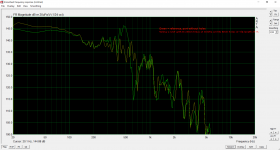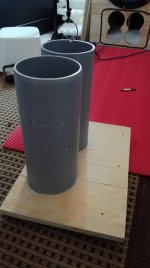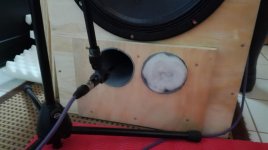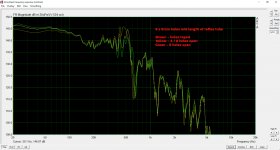Anders,
other way round! At the frequency that causes you trouble your "TL" has a pressure maximum at 1/2 length and the holes vent it.
OK- my keyboard can't do any Scandinavian spelling, so I have to write it in German: "Trink ein Bier."
Pit
other way round! At the frequency that causes you trouble your "TL" has a pressure maximum at 1/2 length and the holes vent it.
OK- my keyboard can't do any Scandinavian spelling, so I have to write it in German: "Trink ein Bier."
Pit
Hi Pit,
I have no problem with this.
My statement early:
Note "but..."
I think holes midway in the length of port will mess up other things.
Pressure differensies inside and outside of port at lower frequensies (and there is a lot) will lead to new noise from air traveling through the holes and in addidion mess up with the hopefully laminar movement of air in port around box tuning freq.
At the frequency that causes you trouble your "TL" has a pressure maximum at 1/2 length and the holes vent it.
I have no problem with this.
My statement early:
It will kill the standing wave but...
Note "but..."
I think holes midway in the length of port will mess up other things.
Pressure differensies inside and outside of port at lower frequensies (and there is a lot) will lead to new noise from air traveling through the holes and in addidion mess up with the hopefully laminar movement of air in port around box tuning freq.
For you swedes in this thread, there has been a few threads on www.faktiskt.se about attenuating the pipe resonances in bass-reflex tubes. The idea is similar to the drilling of holes, some involve adding felt in the holes etc.
The methods seem quite successful in killing the pipe resonances.
The methods seem quite successful in killing the pipe resonances.
Hi Svante!
No doubt about suppressing pipe resonances.
But the potential drawbacks, if holes are exposed to innards of box?
I think that if one created an enclosed volume around port that preferable would be heavily damped. By doing so there would be no problem with pressure/vacuum from box penetrating through the holes. If my memory serves me right this has been done on some commercial speakers before.
I will have some look around faktiskt.se
The methods seem quite successful in killing the pipe resonances
No doubt about suppressing pipe resonances.
But the potential drawbacks, if holes are exposed to innards of box?
I think that if one created an enclosed volume around port that preferable would be heavily damped. By doing so there would be no problem with pressure/vacuum from box penetrating through the holes. If my memory serves me right this has been done on some commercial speakers before.
I will have some look around faktiskt.se
4fun said:Hi Svante!
I think that if one created an enclosed volume around port that preferable would be heavily damped.
As I recall it, someone tested that too. "Phon", I think, but I might be wrong.
4fun said:Hi,
jimangie1973, how is it going for you?
Any success in damping that port resonance yet?
Not yet. I bought some Acoustistuff (synthetic nylon stuffing) that I'm going to line the box with. The box is currently stuffed with generic polyfill with a empty space between each woofer and the port entrance.
The speakers are actually a commercially built model which uses a driver arrangement exactly the same as the Seas Odin/Thor kits(W18E001+millenium MTM). The baffle is 10" wide instead of the 9" of the Odin/Thor. The box volume is about identical to the Odin at approximately 1.2 cubic feet and the tuning frequency is slightly higher than that of the Odin. I bought them used and was disappointed with the sound. I modeled the stock crossover with Matlab. It turns out it wasn't even nulling the W18E001 breakup peak correctly. The notch was a kHz too high. The tweeter circuit was bizarre with a simple first order highpass with a notch at 1 kHz. Needless to say I scrapped the design and tried out Odin crossovers.
Surprisingly, this didn't improve things much. There was too much lower midrange and a piercing upper midrange (3 kHz range). The treble was too supressed as well. I know the baffle step compensation is not quite correct but this doesn't account for all the problems.
I began tweaking the crossover using a Matlab simulation of the driver electrical and acoustic responses (Seas frequency response charts) as a guide. I've also been using a DEQ2496 with a 62 band RTA to get real in-room responses and verify driver phase coherence. This is far from ideal but I've been able to get them sounding very good. The basic topology of the crossover remains but I've changed several values and am currently adding a lower midrange 2dB attenuator (RLC) to the woofer circuit.
The port resonance is really not too big an issue since they are rear ported, but I wanted to attenuate it if possible. Unfortunately the port is glued in very well so I can't experiment with different configurations.
My experience with the Odin crossover makes me wonder about the performance of kits which have been around for several years. Even though the same model, the drivers have probably changed consideraby over that length of time.
Sorry bumping up old thread, but I'm nterested if anyone have experiense to share about perforated port tube.
Googling found a patent which shows good results attenuating pipe resonance in a port but no info about the perforations (size and amount of the holes).
US6275597B1 - Loudspeaker system having a bass-reflex port
- Google Patents
Googling found a patent which shows good results attenuating pipe resonance in a port but no info about the perforations (size and amount of the holes).
US6275597B1 - Loudspeaker system having a bass-reflex port
- Google Patents
Hi all,
did an unscientific test with perforated tube and result was positive to reduce midirange leakage from the port. Also, with quick check in WindISD port effective length seems to be in ballpark what Pit Hinder said, ~1.4 times the actual length with the perforations I made.
I have no clue how this affects the port response on high SPL. All I know that this single experiment reduced midrange peakiness in the port, and raised the port resonating frequency.
the ports are 100mm plumbing pipe, 26cm long. I drilled 8 holes with 8mm bit to the midway of the pipe and another 8 to quarter length. I first taped the holes with gaffers tape and then removed the tape revealing some of the holes at a time. It seemed that the mid leakage and low tuning frequency pretty much walked hand in hand with the amount of open holes.
I don't have outer shell or damping for the holes, they breathe freely to the enclosure.
If one makes a speaker with ported woofer and high crossover to mid and find nastines in midrange by measurements and listening tests this might be a good tweak to try 😉 Make port 1.4 times too long, drill some holes and adjust the low resonance to target with tape.
did an unscientific test with perforated tube and result was positive to reduce midirange leakage from the port. Also, with quick check in WindISD port effective length seems to be in ballpark what Pit Hinder said, ~1.4 times the actual length with the perforations I made.
I have no clue how this affects the port response on high SPL. All I know that this single experiment reduced midrange peakiness in the port, and raised the port resonating frequency.
the ports are 100mm plumbing pipe, 26cm long. I drilled 8 holes with 8mm bit to the midway of the pipe and another 8 to quarter length. I first taped the holes with gaffers tape and then removed the tape revealing some of the holes at a time. It seemed that the mid leakage and low tuning frequency pretty much walked hand in hand with the amount of open holes.
I don't have outer shell or damping for the holes, they breathe freely to the enclosure.
If one makes a speaker with ported woofer and high crossover to mid and find nastines in midrange by measurements and listening tests this might be a good tweak to try 😉 Make port 1.4 times too long, drill some holes and adjust the low resonance to target with tape.
Attachments
Last edited:
- Status
- Not open for further replies.
- Home
- Loudspeakers
- Multi-Way
- Port Midrange Leakage



